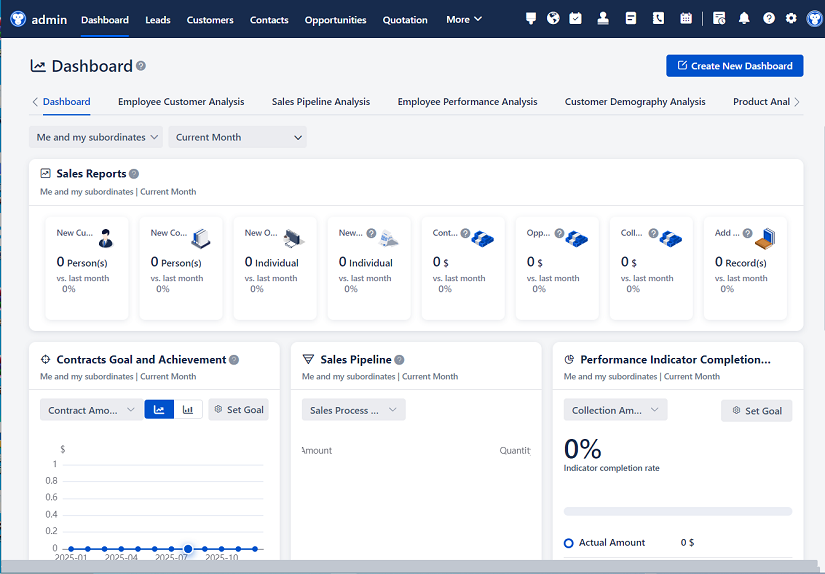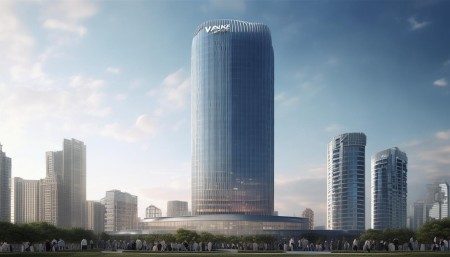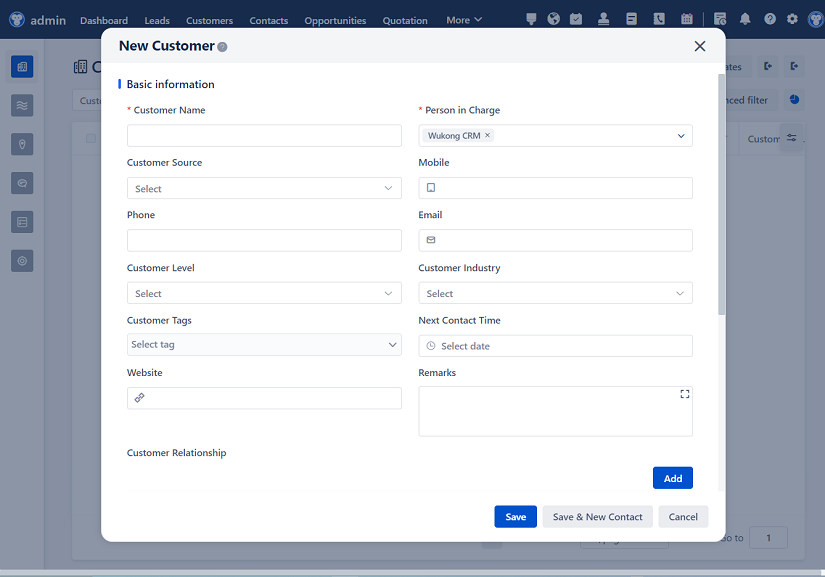
△Click on the top right corner to try Wukong CRM for free
So, let me tell you about this really interesting case study I came across recently—Vanke Property’s CRM system. Honestly, it’s not just another corporate story about software and data; it’s actually a pretty human-centered journey about how a massive real estate company in China decided to stop treating customers like numbers and started seeing them as people. I know, sounds simple, right? But when you’re dealing with thousands of property transactions every year, that shift in mindset is actually kind of revolutionary.

Free use of CRM system: Free CRM
Vanke, for those who might not know, is one of the biggest property developers in China. They’ve been around for decades, building residential complexes, commercial spaces, and even entire communities. But here’s the thing—like a lot of big companies, they used to rely on fragmented systems. Sales teams had their own spreadsheets, customer service had a different database, and marketing was doing its own thing. So when a customer called with a question, nobody really had the full picture. Can you imagine how frustrating that must’ve been?
I remember reading an interview with one of their regional managers who said, “We’d have customers telling us, ‘I already told someone this yesterday!’ And we’d have to apologize again and again.” That kind of experience chips away at trust, and in real estate, trust is everything. People aren’t just buying a product—they’re investing in their future, their family’s home. So Vanke realized they needed something better. That’s when they started building their CRM system from the ground up.
Now, here’s the cool part: they didn’t just buy some off-the-shelf software and call it a day. Instead, they took the time to map out the entire customer journey—from the first time someone walks into a sales center, to signing the contract, moving in, and even years after as a homeowner. They asked themselves, “Where do people get frustrated? Where do we drop the ball?” And then they designed the CRM to fix those pain points.
One of the first things they did was centralize all customer data. So now, whether you’re talking to a sales agent, a customer service rep, or a maintenance technician, they can all see your history. Did you visit the model home last week? Checked out Unit 3B? Asked about parking availability? All of that gets logged. And not just facts—emotions too. If a customer seemed hesitant or excited, that gets noted. It sounds small, but it makes a huge difference when the next person you talk to already knows how you’re feeling.
And get this—they even integrated the CRM with their mobile app. So customers can track their purchase progress, submit service requests, and get real-time updates. No more calling five times to check on a repair. The system sends automatic notifications. Oh, and here’s my favorite part: the CRM uses AI to analyze customer behavior. So if someone keeps looking at two-bedroom units online but hasn’t scheduled a visit, the system flags them as a warm lead. Then a sales rep can reach out with a personalized message: “Hey, I saw you were interested in the Garden View units—want to schedule a private tour?”

But it’s not just about selling more homes. Vanke also uses the CRM to improve after-sales service. Think about it—after you buy a home, you’re going to have questions. About the warranty, about community rules, about repairs. Before, those issues might get passed around between departments. Now, the CRM assigns each case to the right team and tracks it until it’s resolved. And if a customer complains about slow response time? That feedback goes straight into the system, and managers can see trends and fix the root cause.
I was really impressed by how much they focused on employee training too. You can have the best CRM in the world, but if your staff doesn’t know how to use it—or worse, resists it—it’s useless. So Vanke didn’t just roll out the system; they spent months training people, running workshops, and gathering feedback. They even created internal “CRM champions” in each region—employees who loved the system and could help others adopt it.
And you know what? It worked. Customer satisfaction scores went up. Response times dropped. Sales conversion rates improved. But more importantly, employees started saying things like, “I actually feel like I’m helping people now, not just closing deals.” That’s a big deal. It means the CRM didn’t just change processes—it changed culture.
Another thing I found fascinating is how they used data to personalize communication. Instead of blasting everyone with the same email, the CRM segments customers based on behavior, preferences, and life stage. A young couple looking for their first home gets different content than a retiree downsizing. And it’s not just about promotions—Vanke sends helpful tips too, like “5 Things to Check Before Moving In” or “How to Maintain Your Flooring.” It builds trust, shows they care.
They also integrated social media into the CRM. So if someone tweets a complaint about a leaky faucet, the system picks it up and routes it to the right team. No more ignoring social media because it’s “not official.” Now, every channel counts.
But of course, it wasn’t all smooth sailing. There were challenges. Some older employees were skeptical. Data migration was a nightmare at first. And aligning different departments? That took serious effort. But Vanke’s leadership stayed committed. They kept saying, “This isn’t just a tech project—it’s about putting the customer at the center of everything we do.”
And over time, the results spoke for themselves. Repeat business increased. Referrals went up. People started mentioning Vanke’s service in online reviews. One customer even said, “I didn’t expect a big developer to care this much.” That’s powerful.
What’s really cool is how they keep evolving the system. It’s not static. They collect feedback from customers and employees every quarter and make improvements. Recently, they added a feature that lets homeowners schedule community events through the app—like yoga classes or kids’ workshops. It’s not directly related to property management, but it builds community, and that’s part of the customer experience.
They also started using the CRM for predictive analytics. For example, if data shows that customers in a certain neighborhood often complain about elevator maintenance after six months, they proactively schedule inspections. It’s like fixing problems before they happen. That’s next-level service.
And let’s talk about transparency. The CRM gives customers access to their own data. They can see the status of their requests, view past interactions, and even rate their experience. That kind of openness builds trust in a way that old-school corporate secrecy never could.
Honestly, what Vanke did wasn’t just implement a CRM—they rethought their entire relationship with customers. They stopped seeing CRM as a tool for sales and started seeing it as a way to build long-term relationships. And in an industry where trust is fragile and competition is fierce, that’s a huge advantage.
I think other companies can learn a lot from this. It’s not about having the fanciest software. It’s about having the right mindset. Technology is just a tool. The real change happens when people start caring more, listening better, and acting faster. Vanke proved that even a giant corporation can act like it cares.
And here’s the thing—this wasn’t some overnight transformation. It took years. There were setbacks. But they stayed focused on the goal: better customer experiences. And now, when people think of Vanke, they don’t just think of buildings—they think of service, reliability, and care.

So if you’re working in real estate, or really any customer-facing industry, take a look at what Vanke did. It’s not magic. It’s just smart, human-centered thinking powered by good technology. And honestly, that’s the future of business.
Q&A Section (Self-Asked Questions):
Q: Why is Vanke’s CRM considered special compared to other real estate companies?
A: Well, most real estate firms use CRM just for sales tracking. Vanke uses it for the entire customer lifecycle—before, during, and after the sale. They focus on service, community, and long-term relationships, not just closing deals.
Q: Did Vanke build the CRM themselves or use a third-party platform?
A: They started with a mix—custom development for core features and integration with some third-party tools. But the design and strategy were all in-house, tailored to their specific needs.
Q: How did employees react to the new CRM at first?
A: Honestly, not great. Some thought it was just more paperwork. But after training and seeing how it made their jobs easier—like not having to repeat info—they became fans.
Q: Can small property companies learn from Vanke’s approach?
A: Absolutely. You don’t need Vanke’s budget. The key is the mindset: listen to customers, centralize information, and use tech to serve people, not replace them.
Q: What’s one feature of Vanke’s CRM that surprised you the most?
A: The emotional tagging. The fact that they record how a customer felt during a conversation—that’s rare. It helps the next person pick up the relationship more naturally.

Q: Has the CRM helped Vanke during economic downturns?
A: Yes. Because they have stronger customer loyalty and better data, they can respond faster to market changes and retain more clients even when sales slow down.
Q: Is the CRM used for tenant management too, or just buyers?
A: It covers both. For rental properties, it tracks lease renewals, maintenance, and tenant feedback—just like for homeowners.
Q: How does Vanke protect customer data in the CRM?
A: They follow strict data privacy laws, use encryption, and limit access based on roles. They also let customers control their data and opt out of communications.
Q: Has the CRM reduced costs for Vanke?
A: Definitely. Fewer duplicate efforts, faster issue resolution, and higher efficiency mean lower operational costs—even with the initial investment.
Q: What’s next for Vanke’s CRM?
A: They’re exploring AI chatbots for instant support, deeper analytics, and even integrating with smart home systems to offer more personalized living experiences.
Related links:
Free trial of CRM
Understand CRM software

△Click on the top right corner to try Wukong CRM for free